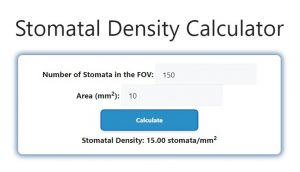About Stomatal Density Calculator (Formula)
The Stomatal Density Calculator is a valuable tool for botanists, ecologists, and students studying plant physiology. Stomata are tiny openings on the surfaces of leaves that facilitate gas exchange, playing a critical role in photosynthesis and transpiration. Understanding stomatal density, which refers to the number of stomata per unit area of leaf surface, helps researchers assess plant health, environmental adaptability, and responses to climate change. This calculator simplifies the process of determining stomatal density, making it accessible for both academic and practical applications.
Formula
The formula to calculate stomatal density (Ds) is:
Ds = S / A
Where:
- Ds is the stomatal density (number of stomata per unit area).
- S is the total number of stomata counted.
- A is the area of the leaf surface examined (usually in square millimeters or square centimeters).
How to Use
Using the Stomatal Density Calculator is straightforward. Here’s a step-by-step guide:
- Prepare Your Sample: Select a leaf sample and prepare it for analysis. Ensure that it is clean and dry.
- Count the Stomata: Using a microscope, carefully count the total number of stomata (S) present on a specific area of the leaf. It’s often helpful to take multiple counts for accuracy.
- Measure the Area: Measure the area (A) of the leaf section you are examining. This can be done using a ruler or by using software tools that calculate area.
- Input the Values: Enter the total number of stomata (S) and the area (A) into the calculator.
- Calculate: Click the calculate button to obtain the stomatal density (Ds). The calculator will process your inputs and display the result.
Example
To illustrate how the Stomatal Density Calculator works, let’s consider an example:
Suppose you counted 150 stomata on a leaf section that has an area of 10 square millimeters.
Using the formula:
Ds = S / A
Ds = 150 / 10
Ds = 15 stomata per square millimeter
In this case, the stomatal density is 15 stomata/mm².

FAQs about the Stomatal Density Calculator
- What is stomatal density?
Stomatal density is the number of stomata per unit area on a leaf, indicating its capacity for gas exchange. - Why is stomatal density important?
It helps understand plant health, photosynthetic efficiency, and environmental responses. - How is stomatal density measured?
By counting the number of stomata within a measured area of the leaf. - What tools do I need for measuring stomatal density?
A microscope for counting stomata and a ruler or software for measuring the leaf area. - Can stomatal density vary between species?
Yes, different plant species have varying stomatal densities based on their environmental adaptations. - What factors influence stomatal density?
Environmental conditions, light availability, humidity, and CO2 levels can all affect stomatal density. - How does stomatal density relate to photosynthesis?
Higher stomatal density generally allows for more gas exchange, enhancing photosynthesis efficiency. - Is there a standard method for measuring stomatal density?
While there are guidelines, methods can vary based on research goals and available tools. - Can stomatal density change over time?
Yes, stomatal density can change in response to environmental stress or developmental stages. - How do I ensure accuracy in my measurements?
Take multiple samples from different parts of the leaf and average the results for better accuracy. - What does a low stomatal density indicate?
It may suggest adaptation to arid conditions where water conservation is crucial. - Are there software tools available for measuring stomatal density?
Yes, some software can analyze images of leaf samples to calculate stomatal density automatically. - Can stomatal density be used to assess environmental health?
Yes, changes in stomatal density can indicate plant responses to environmental changes or stressors. - What unit is stomatal density measured in?
It is usually measured in stomata per square millimeter or per square centimeter. - Does leaf age affect stomatal density?
Yes, younger leaves often have different stomatal densities compared to mature leaves. - Can stomatal density be affected by genetic factors?
Yes, genetic traits can influence stomatal development and density. - What is the relationship between stomatal density and transpiration?
Higher stomatal density typically increases transpiration rates, influencing water loss in plants. - Can I use this calculator for any type of leaf?
Yes, it can be used for various leaf types, but be mindful of specific characteristics that may affect results. - Is stomatal density consistent across all leaf surfaces?
No, different parts of a leaf may have varying densities based on exposure and function. - Where can I find more information about stomatal density?
Research articles, botany textbooks, and academic journals are excellent resources for further reading.
Conclusion
The Stomatal Density Calculator is an indispensable tool for researchers, students, and anyone interested in plant biology. By providing a straightforward method for calculating stomatal density, it enhances our understanding of how plants interact with their environment and adapt to varying conditions. Knowledge of stomatal density not only aids in the study of individual species but also contributes to broader ecological and environmental assessments. Whether you are conducting experiments, engaging in field studies, or simply curious about plant physiology, this calculator offers an efficient way to analyze and interpret vital plant characteristics.